East Creek Ranch Is Better Than Thought
We’ve poked a little fun at East Creek Ranch over the years… from one of their houses in an ad looking like a polygamist compound to questioning the location. This weekend, I had an opportunity to drive around their site that now sports 10-20 homes (in the open area just west of Bells’ gas station).
While I’m not sure I would say the home quality always “looks” like a $700K+ home, I suppose that’s in the eye of the beholder. What I would say is that I’m somewhat shocked by how quiet it was during my visit. I expected the roar of the freeway to make it almost intolerable. That wasn’t the case at all. Perhaps at a different time, noise would increase but there was a steady stream of traffic while I was there and it was a low buzz at worst.
It may be because there is no mountain behind the area to block the sound in and the fact that the houses are a little below the freeway probably helps. Of course, your tastes may vary. So, if you are looking there, please make up your own mind.
All that said, I can envision a time when the area is filled with houses, and families with little kids race between them. Once it’s built out, it very much seems like it could be another area like Silver Summit (Foxcrest Dr, Sagebrook, etc.) where those of us who work here can also live and raise a family. That’s probably not a bad thing.
Anyone Want to Bet What the Kimball Junction Transit Center will Ultimately Cost?
Sometimes when I’m following news events around Park City, it reminds me of the book 1984. A key theme is that “We have always been at war with Eastasia” until they are no longer at war with Eastasia and then the statement becomes, “We have always been at war with Eurasia.” No one stops to ask the question, “Huh? How did that change happen?” I suppose that’s one of Orwell’s points.
I feel that way with the Transit Center that’s about to be built behind the library in Kimball Junction. The Transit Center will in effect be a really nice bus stop that is supposed to improve the efficiency of the entire Park City bus system by providing a location where riders can switch buses to get to their destinations more easily.
So, please let me take you through the last year, that relates to the Kimball Junction Transit Center, through a few Park Record quotes:
Summit County Council green lights transit center at Kimball Junction (2/13/2015)
“Park City Transit was recently awarded a $1.7 million grant from the Federal Transit Administration for the construction of the $2.4 million project. The County Council contributed $500,000 and Park City Transit provided $95,000.”
Kimball Junction transit center project rolling along (July 7, 2015)
“The Federal Transit Administration awarded Park City Transit a $1.7 million grant last year for the estimated $2.4 million project. Summit County contributed $500,000 and Park City Transit provided $95,000, leaving an approximate $105,000 deficit.”
Kimball Junction Transit Center project gains ground (January 8, 2016)
“The Federal Transit Administration awarded Park City Transit a $1.7 million grant last year for the project, which is estimated to cost slightly more than $3 million. Summit County has contributed $900,000 and Park City Transit provided $95,000. Park City Municipal is administering the request for qualifications because it is the Federal Transit authority grantee, Radke said, before adding that it is “still a county project.”
It’s funny what happens over the course of eleven months. We start with February 2015 where the center will cost $2.4 million, Summit County will contribute $500K, Park City pitches in $95K, and Orrin Hatch the federal government provides a grant of $1.7MM.
Then in July 2015, the Park Record points out there is actually a deficit of $105K in the plan… that someone will need to find in order to build this transit center. Fair enough. That deficit was probably always there but just wasn’t pointed out.
Fast forward to this weekend, when the Park Record tells us that Summit County is now chipping in $900K instead of $500K, which is an 80% increase. We also learn that the entire project will cost more than $3MM versus the $2.4MM previously stated. That would be at least a 25% increase in overall cost versus what we were initially told.
If that wasn’t bad enough, it looks like still more money will have to be “found.” Using our public school math skills, we can try to figure out whether we have budgeted enough money for the project. So, we need a little over $3MM dollars. Let’s call it $3.1MM. What do we have allocated?
1,700,000 (Federal Grant)
+ 900,000 (Summit County)
+ 95,000 (Park City)
_____________________
$ 2,695,000 (Total)
Again, I’m a product of public school, but $2.7 million seems to be less than the $3.1 million required to build the transit center. So, it is likely someone will have to come up with an even additional $400,000 difference. Anyone want to guess who will be paying that additional money?
Yes, it will be you and me. That will likely bring Summit County’s total bill to $1.3 million, if it stays on budget once building starts.
Of course, that investment of $1.3 million may be worth it, should it take a substantial number of cars off the road. However, the question I continually ask is, even if the bus system gets slightly more efficient, will people get out of their cars and ride a bus. I may be proven wrong but I think that is highly unlikely.
This project seems like a last-grasp at a solution to make our buses work better. Perhaps our local governments have run out of ideas.
We’ve heard people don’t currently take buses because it takes three times as long as driving (on an average day). So, this idea gets introduced to put in place a transit center, and make buses “more efficient.” I suppose if this transit center let’s me get to the Canyons to ski in 20 minutes (total time from leaving my house) instead of the 15 minutes I may give it a try. I bet my wife would take the bus if she could leave our house in Jeremy and be to work in Prospector within 35 minutes. Right now, it usually takes about 20-25 minutes via car.
I frankly just don’t see it.
Last February, this just seemed like wasted money. Now, it just seems like more wasted money. I hope I’m wrong. We all want to get where we are going faster and we want our tax dollars used well. I’m frankly not sure whether this will do either.
That said, we’ll be tracking bus riding numbers. If this transit center equates to vastly improved ridership, we’ll let you know. Likewise, if it doesn’t, we’ll let you know that too.
Oh the Carnage!
Only one day of off-leash dogs being legal in Round Valley and the death and destruction has already started. We found this skull on the trail. My 3 year old and I debated whether it was dinosaur or human…
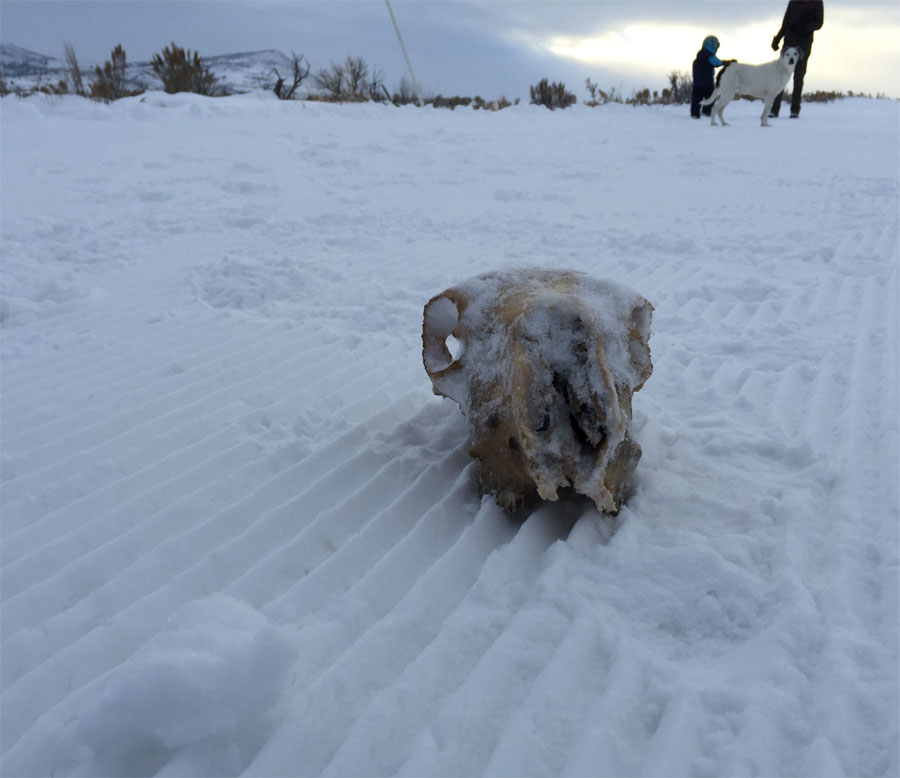
Are People Moving In Or Out of Utah?
One of the trends I try to follow is whether people are moving to Utah or whether they are leaving. This is important because it helps to tell us about what kind of growth we’ll see in Summit County. If more people are migrating to Utah, this puts more pressure on us here around Park City, because it is a desirable place to live.
Of course, it’s not the only variable to take into account. There are the number of births, which Utah is generally good at (Park City less so) and people who migrate here from in-state. Take all three and you have a good idea of growth pressure on our area.
Each year, United Van Lines publishes a migration study between states. This is helpful because while the government provides good population given census data, other years are just estimates. The United Van Lines study also provides data on what demographics are moving, which is helpful. So, what does Utah migration look like in 2015, according to United Van Lines Data? In the graphics below, you’ll see that the moving company’s data shows people are leaving Utah.
Below we show the United Van Lines map and the reasons its customers say they are leaving. If you are interested, click this link and you can see how this has changed over the years. It’s pretty interesting to see the people moving in after the Olympics.
Of course, this is one small subset of data. So, that has to be factored in. It also does not account for birth/deaths and in-state migration. However, it does provide some interesting information.
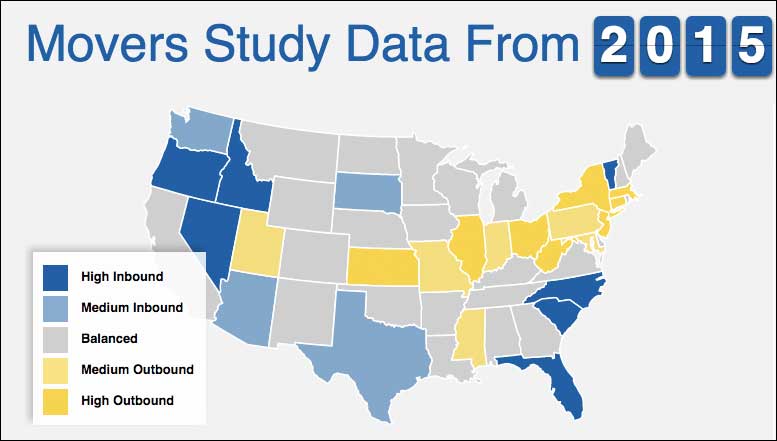
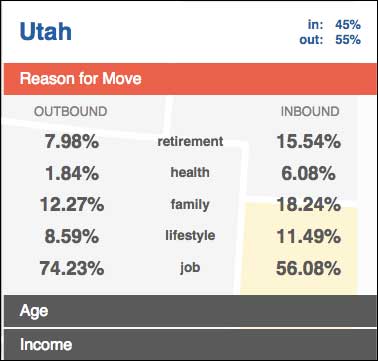
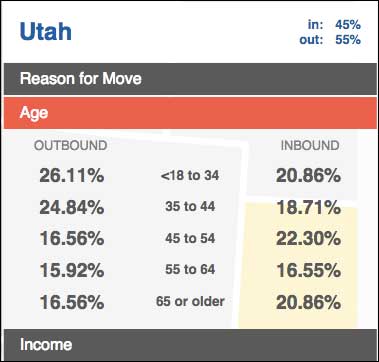
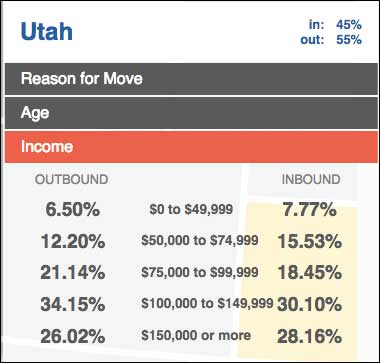
Park City Sucks
In late December I wrote a column on how Park City may have made a big mistake by letting Vail use the term Park City for their ski resort. Since that time I’ve done research, thought more about the topic, and frankly become more upset that our community is now forever tied to a Vail ski resort name.
As a protest, and in order to provide criticism, Park Rag LLC has purchased the website www.parkcitysucks.com. As we state there, we don’t think Park City (the city) is horrible. We don’t think Park City (the resort) is bad. However, we do think Vail’s use of our city’s name, PARK CITY, for their ski resort SUCKS. In addition, we worry about the effects on local businesses who may want to incorporate the words “Park City” in their name going forward.
In the end, parkcitysucks.com simply asks Vail to reconsider what they have done, for all our sakes.
If you have a few minutes, we’d love for you to check it out.
Elected Officials Please Don’t Spread False Information
While I know most elected officials try to get it right, when they don’t, and you know they don’t, it calls into question all of the decisions they make. The most recent example was this morning on KPCW. KPCW’s Leslie Thatcher was interviewing Park City council members about yesterday’s city council meeting on Round Valley as an off-leash dog area. The topic of electronic collars came up and one of the city councilors said that there was a concern that the collars were too expensive to require everyone to have one. A council person then said they cost $150 on Amazon and $250 in local stores.
That shocked me, since I bought mine on Amazon for under $40 and it works great. Don’t believe me, here is a search for electronic collars on Amazon. Ninety percent of these collars are under $70. One with 4.5 stars out of 5 stars, with 370 reviews is only $25. Now, whether everyone should be required to have one is a completely different argument or whether $25 is too much money is another… but please don’t spread bad information about these collars costing hundreds of dollars.
It’s the same sort of issue I have seen in school board meetings where members will talk about the “bad” water at Treasure Mountain, with one of the school board members saying on the public record that she won’t let her kid drink the water there. Is the water pristine, like drinking filtered Perrier, probably not… Is the water toxic per EPA standards? No. Another comment was made about the toxic soil in the air ducts at Treasure Mountain. Has some dust/dirt spread into the vents coming from outside the building (where some of that dirt may contain lead)? Yes. However, first I still ask the question is that lead bio-available (meaning, is it actually harmful to humans). Second, does any of the air coming out of the ducts hundreds of feet away (you know, where it is actually breathed in) have any lead in it and has that been tested? No. If it was, and it was dangerous, the school would be shut down.
If it’s not a real problem, don’t say it.
Our elected officials need to be held to a higher standard. For the most part, when they talk, we listen. However, when they talk, and WE KNOW THEY AREN’T RIGHT, it strains their credibility. The natural progression of that is to ignore what they say because if they are wrong on A, B, and C… they are probably wrong on D, too. That’s not a good place for anyone to be. The School Bond process showed us what happens when trust and credibility is lost, and I don’t think anyone really liked how that worked out.
Save $20 to $40 a Month on Your Electric Bill
Most people are looking for ways to cut back and not waste money. While some people may be aware of a strategy for cutting your electric bill, I stumbled into this one during Christmas.
We put our heat tape on our house (keeps the ice dams from building up on the north side of our roof) on the same timer we used for Christmas lights. So, it ran for about 5 hour a days (5-10PM), instead of the 24 hours a day it usually runs.
What was the difference in performance? Almost nothing. No ice dams formed and the snow melted off. However, if we calculate the energy difference it is huge. Before, our heat tape was running about 2800 hours a season (December through March, 24 hours a day) and now given the timer it will run about 600 hours. I have about 100 feet of tape running and this webpage estimates the cost. It likely costs about $65 per month to run it 24 hours a day. My five hours a day costs about $20.
Further research shows there is a more effective strategy than running the heat tape at night. It appears running heat tape during the day is actually more efficient. Our own Summit County Power Works has a page on using heat tape effectively. Park City and Summit County have dropped into 6th place for the Georgetown Energy Prize. Adding a timer to your own heat tape setup may be an easy way to contribute to the effort and try to push us back to the top.
Of course, any time your are dealing with electricity (especially when it’s used to heat up a wire that you are attaching to your house), you should use caution. You would want to choose an appropriate outdoor timer for your heat tape and ask a professional (or perhaps the Summit County Power Works) for advice.
That said, it’s a solution I stumbled into, and looks to be an easy way to curb energy use during the winter months in Park City and Summit County.
Why the U.S. Should Never Host Another Olympics
Remember the 2002 Olympics? A lot of people felt that was the moment that put Utah on the world map. Fourteen years later, with traffic woes and population continually increasing, many people probably wish we’d flew a little more under the radar. Yet, it looks like state leaders are ready to champ at the bit again. Governor Herbert in July said, “We are capable of hosting the Winter Olympics again. In fact, I would say we are the best place, not only in North America, but maybe the best place in the world to host a Winter Olympics again.” right before signing resolution that says Utah is ready, willing, and able to host the Olympics again. Jeff Robbins, Utah Sports commission president and CEO said, “Ready, willing and able is our motto. We’re in a great position should a winter bid become available.” And if you don’t think the Mountain Accord’s train concept up Little Cottonwood isn’t tied at all to an Olympic bid, I think you’re missing something.
The question is, does the average Utahn want another Olympics? I realize the Governor does, so he can tout the economic benefits that may (or may not come). I realize those with businesses (or work for businesses) that would benefit from tourism might want another Olympics. I would guess government agencies that would get an infusion of cash to improve infrastructure would probably be all for another Olympics. However, what about you… would it be good for you? Personally, I’m not sure what benefit it would bring me or my family? Most importantly, I can see the downsides.
With that as a backdrop, Outside Magazine has just published an article entitled Why the U.S. Should Never Host Another Olympics. It’s an interesting read that begins with how Boston dropped out of the running for the 2024 Summer Olympics (due to potential costs), touches on the bribery that took place in getting the 2002 Olympics in SLC, and speaks to how petulant the IOC acted when Norway said “No thanks” to the 2022 Winter Olympics due to IOC member demands and the financial cost. Yet, it provides a number of other arguments:
- Olympic building and hosting processes damage the environment.
- “The Games overrun with 100 percent consistency. No other type of megaproject is this consistent regarding cost overrun,” concluded a 2012 study by Oxford University economists Brent Flyvbjerg and Allison Stewart. Think about that for a moment. Every Olympics, from 1960 through 2012—and that doesn’t even count the massive Sochi boondoggle of 2014—has run over budget. And not by just a little.
- With an average cost overrun in real terms of 179 percent—and 324 percent in nominal terms—overruns in the Games have historically been significantly larger than for other types of megaprojects, including infrastructure, construction, ICT, and dams…
- The IOC insists that hosting is a huge honor for any city. The Games, it argues, lead to all sorts of wondrous economic, social, and athletic miracles . This isn’t true. Stephen Billings, an economics professor at the University of North Carolina at Charlotte, who has studied the economic impact of hosting the Games… he says having an Olympics in your city is, at best, “a wash.”
- Even that best-case scenario turns out to be bad for a city and country. When economists James Giesecke and John R. Madden of Monash University looked at the Sydney 2000 Games—with a view toward asking what would have happened if the money had been spent in other ways—they found that “in terms of measurable economic welfare, the Sydney Olympics came as a cost to Australians, reducing the present value of real private and public consumption by $2.1 billion.
- The only Olympics in modern times that officially didn’t lose money were the 1984 Summer Games in L.A. Despite cost overruns, chief organizer Peter Ueberroth sold the hell out of them to TV and corporate sponsors, and L.A. bragged that it made more than $200 million on the deal. But that’s creative accounting. When city organizers tally up costs versus income, they conveniently leave out the government’s—that is, taxpayers’—share.
- They estimate costs for security at the 2022 game in LA will at least cost $1.5 Billion.That money could be used to install solar on 150,000 Los Angeles area homes.
The best quote of the article comes at the end… “Let them [Other countries] have it. Let them build white-elephant stadiums and Potemkin villages. We’ve got schools and bridges to raise, teachers to pay, parks to create and maintain. The United States doesn’t need the Olympics.”
I’ve heard through the grapevine that some of the “powers that be” think Utah may be able to host an Olympics for the “paltry” amount of $1 billion, since a lot of the infrastructure from 2002 still exists. I’ll believe that when I see it (and also remember that every Olympics goes over budget). I’ll also remember that $1 billion is ONE BILLION DOLLARS. Somebody is going to pay for it…and there will likely be a lot of Utah tax dollars in there.
Of course, I never want to speak for everyone. Perhaps the majority don’t care about spending tax dollars on two weeks of Olympic fun, think the benefits will outweigh, or just think it would be neat. Fair enough. What I do hope is that before Utah commits to throwing our hat in the ring, they do a public vote to make sure the people agree. If not, a whole lot of people are going to be on the hook for something they may not want at all.
A Message from Wild Aware Utah
A representative from Wild Aware Utah reached out to us with information related to the recent shooting of the Cougar in Summit Park. If you are interested in the topic, you may want to give it a read:
Hi Park Rag Readers!
I wanted to let everyone know about our collaborative, state-wide wildlife awareness and safety program called Wild Aware Utah.
With some Park City residents worried about the recent sighting and then shooting of a cougar in Summit Park after it killed a family dog, it is more important than ever to get wildlife safety tips out to the community.
The goal of the Wild Aware Utah program is to create awareness throughout Utah that will foster new attitudes towards wildlife and motivate behavior changes in people, resulting in minimizing conflicts with wildlife.
Utah’s Hogle Zoo founded the Wild Aware Utah (WAU) program in 2009 with the Utah Division of Wildlife Resources (UDWR), and Utah State University Cooperative Extension (USUCE). Wild Aware Utah partners and affiliates work together to develop tools to educate individuals and communities about how to live, work, and recreate safely in wildlife habitats in Utah.
The Wild Aware Utah program does not take positions on wildlife issues or policies. The materials are designed to be fact-based, neutral and applicable throughout the state. Our free materials provide simple guidance and direction for Utah communities through these three main messages:
- Be Aware of the wild: Learn about wildlife.
- Share the wild: Respect and change behaviors.
- Care for the wild: Take action, coexist safely and help wildlife stay wild.
WAU program relies on grants and donations to develop materials so that all our resources can be offered free to communities desiring to use them.
Why is such a program needed?
As the human/wildlife interface expands through housing and other developments throughout Utah, rural areas are becoming more urbanized. And with outdoor recreation becoming increasingly popular, there is an increase in the number of citizens concerned about how to be safe in these areas. As Utah continues to grow, and as humans and wildlife compete for space, the number of conflicts will increase. Various non-profit organizations and state agencies have recognized the need for awareness and safety education.
Wild Aware Utah is an Educational Tool:
WAU materials are available for Utah organizations and agencies to distribute and use throughout their communities. Local Utah groups are invited to use Wild Aware Utah materials to train their own volunteers from their community to spread Wild Aware Utah messaging.
Website:
WAU website provides wildlife identification tools, coexistence and safety tips as well as wildlife emergency contact information. We have links to our partner’s and affiliates websites, and other organizations throughout Utah. Check it out at:
Wild Aware Utah representatives can provide free presentations to community, school and youth or scout groups. If anyone is interested in hosting a presentation please send us an email at
“Eats Park City” Campaign for Healthier Food in Park City Schools
If you are concerned with the school lunches at Park City schools, you may want to check out their Hungry for Healthy Campaign. They are trying to get the following 7 types of ingredients eliminated from Park City School District school lunches:
- Trans Fats and Hydrogenated Oils
- High Fructose Corn Syrup
- Hormones and Antibiotics in beef and other animal products where possible
- Added and Artificial Sweeteners
- Artificial Colors and Flavors
- Artificial Preservatives
- Bleached Flour
If you’d like to learn more, you can check out their website. If you’d like to lend your signature to their campaign, you can sign their petition by going to their Petition Page.
